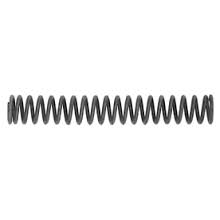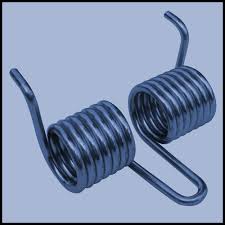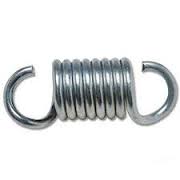Think Like A Cop
- TLAC YouTube Channel
- TLAC BitChute Channel
- Random Thoughts
- Page Sitemap
- DONATE HERE
- Truth About Gun Control
- YouTube Blocked Videos
- On Sheep & Wolves
- Rick's Bio
- Fight Or Flight
- Gun Spring Fatigue
- Cowboy Wisdom & Quotes
- Search Warrants
- RPM Of Bullets
- *Photos Rick and Horses
- Military Manuals
- Random Horse Thoughts
- *Contact Rick
Do Gun Springs Wear Out
Spring Fatigue Made Easy
Does It Hurt Mag Springs To Keep Them Fully Loaded
On this page, I hope to clear up some terms, beliefs, share some opinions about spring wear, spring fatigue, spring set, and spring lifespan and I hope to make this topic as clear as mud. However, after you read this, you will know more about springs than most gun owners giving advice aboot how to load your magazines.
This topic usually boils down to about three opinions. One, don"t worry
about it. Two, rotate and change your loaded mags. Third, don"t fully load
your mags leave one or two rounds short.
Like many subjects in life the right answer is normally, "It Depends."
If you own guns, springs are part of every gun. Every time a gun shoots you
use anywhere from one to six or more springs. Surprisingly there is not a lot of clear information about spring use, abuse,
cleaning, wear or failure. (A Glock pistol has six springs)
When it comes to this topic you will normally find two types of people, the
worry warts with more money than sense that want to replace springs every
six months, and the others are I don"t care since I heard from a friend that a gun was
found from WWII loaded for 30 years and it fired and worked fine.
So which is it? Well I think the truth lies somewhere in between. I would
hope after you read this article that you will, at least, have a better
understanding of springs, so you can make your own educated decision.
Let"s start with what a spring is. A spring is an elastic object used to
store mechanical energy. That energy is stored and released. When a spring
is said to be neutral or set, it has neither stored nor released energy,
per say.
* Springs can get worn out, but more by neglect and using them not for their intended use.
Springs come in three main types and guns use all three.
The most common types of springs are Compression (Coiled), Torsion
(twisting) and Tension (extension).
Coiled springs
appeared in about the 15th Century in door locks and spring
powered clocks. Coiled springs is what you have in your guns like your
buffer spring, magazines, recoil spring and extract/ejector springs. Coil
springs work when they are compressed from its resting position and that
energy is released when it is decompressed. The spring exerts an opposing
force approximately proportional to its change in length. So when it is not
compressed there is no stored energy to release. Compression springs can be
prone to buckling, which is why some use guide rods or small enclosed areas
that support the spring, to prevent buckling.

Torsion spring is a spring that works by twisting. Torsion springs give energy when torqued or twisted. When it is twisted it has stored energy that can be released. In guns, these springs are most commonly found in the Trigger or slide lock/release.

Tension or extension springs tend to pull things back to position. A tension spring is a helical cylindrical spring with approximate constant stiffness which is able to receive external forces acting away from each other, on its axis.

The Difference Between Conventional and Variable Springs:
The difference is both physical and operational. With a conventional
spring, all the coils are spaced equally apart, except for the closed ends.
In a variable recoil spring the space varies between coils with less space
between coils at one end and more space between coils at the other end.
The way the two springs store energy is also different. For example if a
conventional recoil spring is compressed 1/2", it might store 1 pound of
energy. For every additional 1/2" this spring is compressed it would then
store 1 additional pound of energy. When a variable recoil spring is
compressed 1/2", it might store 1/4 pound of energy. The next half inch of
compression might store 1/2 pound, the next half inch might store 3/4 pound
and so on. In other words, a conventional spring stores energy on a
straight line and a variable spring stores energy on a curve. If both
springs are rated at 16 pounds, they will both store 16 pounds when
compressed to the same working length, but the way they get to 16 pounds is
different. (unknown source)
Now we that we know the types of springs, let"s take a look at the
different materials used in making springs.
Music Wire:
This is a general term referring to a range of high carbon steel wires. The
term "music wire" is used because guitar and piano strings are typically
made from this type of material. It is the most common material for small
springs.
Chrome Vanadium:
This is an alloy steel. It has small amounts of both chromium and vanadium
added to it to allow it to withstand higher operating temperatures. This
material can be plated.
Chrome Silicon:
Another alloy spring steel with typically just over 1 percent silicon added
to increase heat tolerance. This material can be plated with proper
techniques.
17-7 PH Stainless Steel:
This is a high strength cold drawn and precipitation hardened stainless
steel. This material typically has a blue to brown color after heat
treating. It has general-purpose corrosion resistance. It is magnetic in
spring temper.
-
Springs can be made from hardened steel or can be hardened
afterwards depending on the process
Many think the best spring materials are chrome silicon (CS) alloy and 17-7 PH (mil-spec stainless steel). CS
springs will endure 500,000 cycles with
single-digit performance loss percentage. CS can also be heat-treated (also
called hardening or tempering) and shot-peened after forming to enhance
spring-to-spring consistency and better performance. CS also endures heat
up to 750 degrees Fahrenheit with no changes, however music wire can
diminished at about 175 degrees Fahrenheit. So obviously, where the spring
is being use will dictate how much heat it will be exposed to.
Most common spring materials generally fall within each other to a 10
percent window of strength. So the fatigue limit (lifespan or failure
point) of the various materials, doesn"t really vary that much, under most
conditions. Physical design factors such as wire thickness, number of
coils, surface finish and care of the spring have a larger impact on the
life of the spring more than anything else.
All materials have their advantages and disadvantages, so many
considerations go into play when designing springs for specific intended
uses. So when gun manufacturers pay engineers to design, test and develop
springs, they probably know what they doing in order to prevent failures,
accidents and lawsuits.
What Causes A Spring to Fail:
This seems to be where most people part. My philosophy, in the past, has
always been, why keep a spring under tension when you don"t have to? I am a
little old school and was programmed with information from the Vietnam era,
when the M16 was first used and had many failure problems that got people
killed, so that is where that belief comes from. However, with the
advancement of materials, education, coating and standards, I have come to
change my position.
By definition, a static load (e.g., a once-loaded mag stored indefinitely)
can never produce fatigue failure. You need a cyclic load (e.g., a
repeatedly loaded and unloaded mag) to create fatigue.
Springs fail from various causes. Some of these are improper uses, lack of
care and neglect, metal fatigue, corrosion, damage, extreme hot or cold or
small percentage of production failure.
Fatigue or metal fatigue, is the failure of a component as a result of
cyclic stress. The failure occurs in three phases: crack initiation, crack
propagation and catastrophic overload failure (lack of care and rust
increase the chances of all three). Fatigue failures often result from
applied stress levels significantly below those necessary to cause static
failure. An example of static failure would be a fully loaded magazine just
sitting there, the spring is dirty, rusts, weakens and then the spring
breaks. Very rare and I have never known this to happen. Cyclic stress is
compressing AND stretching of the spring which puts more wear on a spring
than just sitting, both with no load (unloaded) and under load (loaded).
However, mag springs are designed and engineered to be loaded and unloaded,
so using them does not damage the spring. If you are over loading them or
taking the mag apart and stretching the spring out, then you are not using
them, in a way that they were NOT intended or designed.
Fatigue may be the wrong word. When a spring is cycled many, many times it
can crack from metal fatigue. Most modern springs generally will go from
100,000 to 10,000,000 flexes before failure due to fatigue (unknown source). Remember, extreme cold or heat will also effect
spring performance and fatigue.
Spring fatigue happens when you repeatedly compress and release a spring.
Over time, the "cycling" of the spring from a compressed state to a
relatively uncompressed state will weaken the spring in area where there
may be tiny imperfections in the metal. How quickly this may happen depends
on the type of metal used, the conditions of use and the frequency of
cycles. Engineers define metal fatigue as weakening or failure resulting
from cyclic loading (loading / unloading). A static load (not moving) does
NOT cause fatigue.
The greatest danger to guns springs is corrosion. Springs are typically the
thinnest metal in a firearms which make them extremely vulnerable to
catastrophic failure from corrosion. Design parameters allow for this which
is why stainless steel seems to be a popular choice for firearm springs.
Spring Set:
Manufacturers plan for and work "spring set" into the design of springs.
Springs can and will get what is called "spring set".
Basically this is when a spring is put under load for the first time, it will shorten and lose some of its
length and range of motion. Spring set can work both ways, when pulled in
opposite directions or when compressed. Spring set is not the same as
spring fatigue, unless you are over compressing or stretching. Older
springs, probably before 1940 or so, are more likely to take a "set" if
left compressed than newer springs made today.
Metal fatigue is generally a term used to attribute failure to metals -
work hardening, crystallization - failure due to inclusions, voids, poor
heat treatment etc. A spring works thru torsion - a spring that is brand
new when left compressed will almost inevitably take a small, but
measurable ""set"". Once that has occurred the life of the spring will be
longer than most things they are in and longer than you will be around.
Spring set is normal and is not a concern and should not be corrected. I.E.
Attempting to stretch the spring to make it longer. Modern day springs are
heat treated and tempered which means they would return to length even
after 10 years of compression.
What is Creep:
Creep is a slow degradation in the strength of a metal used in a spring such that over time it loses its elastic capabilities. Spring creep is usually a concern under extreme conditions. Creep normally doesn"t occur at room temperature. As a rule of thumb, creep processes occur at about melting temperature. When the spring is compressed or expanded beyond its normal range, usually causing heat, creep can happen. Compressing a spring and stretching it beyond what it was designed to handle, will indeed, cause the spring to deform.
Shot Peening:
Shot peening is a cold work process used to finish metal parts to prevent fatigue and stress corrosion failures and prolong product life for the part.
Hardening and Tempering:
Metal hardening processes is a way of making steel harder. By first heating
the steel and then quickly cooling (quenching) it, the steel will become
much harder, but also more brittle. Steel can be treated by intense heat to
give it different properties of hardness and softness. This depends on the
amount of carbon in the steel (only high carbon steel can be hardened and
tempered).
Tempering is a low temperature (150 C / 302 F to 650 C / 1002 F) heat treatment intended to
remove the stresses and brittleness caused by quenching and to develop the
required mechanical properties.
Some Science Behind Springs:
Young"s modulus:
Young"s modulus, also known as the elastic modulus, is a measure of the
stiffness of a solid material. It is a mechanical property of linear
elastic solid materials. It defines the relationship between stress (force
per unit area) and strain (proportional deformation) in a material.
Material stiffness should not be confused with strength, hardness or
toughness.
Strength:
the strength of material is the amount of force it can withstand and still
recover its original shape;
Geometric stiffness
: the geometric stiffness depends on shape, e.g. the stiffness of an I beam
is much higher than that of a round tube made of the same steel, thus
having the same rigidity, and same mass of material per length.
Hardness:
the hardness of a material defines the relative resistance that its surface
imposes against the penetration of a harder body.
Toughness:
toughness is the amount of energy that a material can absorb before
fracturing.
As long as they are not stretched or compressed beyond their elastic limit,
most springs obey
Hooke"s law,
Hooke"s law
is a principle of physics that states that the force F needed to extend or
compress a spring by some distance X is proportional to that distance. That
is: F = kX, where k is a constant factor characteristic of the spring: its
stiffness, and X is small compared to the total possible deformation of the
spring. (This just gave me a headache)
The Modulus of Elasticity
(also known as the elastic modulus, the tensile modulus, or Young"s
modulus) is a number that measures an object or substance"s resistance to
being deformed elastically (i.e., non-permanently) when a force is applied
to it.
Some Not So Scientific Evidence:
A paperclip is like a spring, it holds it"s shape, but if you bend it out
of its set shape or bend it back and forth several times, it will heat up
and break. Springs are made of much better materials and processes but the
same is true. If you bend them out of shape, use them for other than their
intended purpose or expose them to extremes heat, abuse or use, they can
fail. However, with normal intended use and proper cleaning and care, good
quality springs are pretty reliable and not likely to fail in your
lifetime.
One man said, I have a gun, which turns 100 in two years. Works great.
Incidentally, one of the selling points of that shotgun was that the springs were guaranteed never to take a set. I have a letter
from Ithaca to my grandfather, dated 1949 reaffirming that guarantee on the
springs. They said never and they meant it. Ithaca is gone, but those
springs are still fine. (*note: if they were making springs that good in
49, should you really worry about springs made today)
Another man said, How many of you have ever made a spring? I have probably
made more springs than everyone reading this article, combined. Modern
springs may take a slight set the first time it is compressed. After that
it should work indefinitely. Signed: Bill DeShivs, Master Cutler
And another man makes this point, Tomorrow I"ll drive a car to see my
family. For the engine, that"ll mean five hours at a minimum of 2000 rpm.
Each valve spring will be compressed every second revolution, or 5 x 60 x
2000 / 2 = 300,000 times. Roughly a thousand times per mile. So far the
valve springs in my car have been compressed and released about a hundred
million times. Last time I checked changing valve springs is not on the
inspection list. They"ll be good for another one or two hundred million
compressions. And there are people worrying about magazine springs that
will be a compressed and released a few hundred or thousand times at the
most. (This statement makes a lot of sense to me)
And I say, in 30 plus years of military and police work, working with guns
my entire life, I have never seen, heard of, or known anyone that has had a
spring fail in a gun. Now I have had to replace a few springs from being
modified, cut, filed, bent, stretched, put in wrong and rusty, but never a
spring used normally and cared for. At mitcalc.com they go over springs
design and tensions testing, it appears their standard for spring testing
and failure is 10 to 5th power, (100,000), so it is reasonable to believe
that most springs will last 10s of 1000s of times under normal usage, much
more than anyone will ever load and empty a magazine. In the big picture, I
don"t think a lot of time should be spent worrying about springs, other
than cleaning.
Some Suspicious Recommendations From Spring Sellers:
This is an excerpt from a Lucky gunner article:
How often is "periodically"? That"s a great question. A gunsmith at Beretta
(who claimed not to be speaking on behalf of the company) told us he
rotates his personal carry magazines every two weeks.
The customer service rep we spoke to from Sig said that once every six
months would be sufficient.
However David Cochol of Mec-Gar, the company that manufactures the factory
magazines for Sig (as well as Ruger, S&W, CZ, and several others), gave
us the answer that seemed most common; "We recommend following standard law
enforcement practice and that"s to rotate magazines every 90 days." He also
suggested that rotation as a good opportunity to field strip, clean, and
inspect the magazines to make sure there aren"t any other problems that
could cause malfunctions.
My response to this, I have never heard of any law enforcement agency
rotating mags or for that matter taking apart mags and cleaning them. So
not sure where the hell they got that from. However, I always say don"t ask
a Barbara if you need a haircut and don"t ask horseshoer if your horse
needs shoes. When you ask someone that sells something if you need one,
they will always tell you YES. So when a spring manufacturer, Wolff Gun
springs, tells you that you need to replace springs every six months, I
call horse pucky. If you are making springs that are so crappy they need
replacing every six months, perhaps I should not be using your springs.
Miscellaneous Stuff and Common Sense Factor:
Many people say loading and unloading does damage to mag springs. Magazines
are made for loading and shooting (unloading them). That is their intended
use.
If you have a mag issue and think it is a spring, mark that mag with "T"
for training mag and use it at the range to help you practice failure
drills and tap and rack drills.
New mags are always hard to load, over time they load easier. This is
normal and should not be a concern. This is not spring failure and may be a
little bit of spring set.
Dirt, lack of care, rust and neglected springs will deteriorate springs
more quickly than use.
Magazine maintenance is the difference between have an expensive single
shot or a working semi auto.
Springs are made to work within the range that they were designed for, use
them that way.
Fully loaded mags can be hard to seat in a weapon from too much pressure,
normally created by someone trying to squeeze one extra round and force it
into the mag. That little bit of play after a mag is fully loaded is there
intentionally so the mag will load under pressure.
A two dollar magazine will not have the same spring as a 15 dollar
magazine.
Needless administrative handling breeds complacency and should be avoided.
(Safety Sally's)
A 30 round mag is designed to hold 30 rounds, loading it with 29 rounds
makes it a 29 round mag, to my knowledge, they do not make, design or
manufacture 29 round mags.
In Conclusion:
Will you ruin a mag spring by keeping it fully loaded? Are springs really a
valid concern if they are cared for and used for their intended uses? Do
springs really need replacing every six months? These are questions that
you have to answer for yourself. I hope this information helps you in
making your own informed decision.
For me, spring failure and spring concern is in the category of I don"t
worry about it too much.
Some Links and Reference Sites On Springs:
Site about spring designs:
http://www.meca.insa-toulouse.fr/~paredes/Springs2K/index.php
Site with a spring specs calculator:
Site about springs:
Site about Spring Failure and other Spring information:
http://staffhome.ecm.uwa.edu.au/~00052817/DANotes/intro/contents.html#top
Site about types of spring material:
http://www.whitesounddefense.com/pages/Gun-Spring-Materials.html
